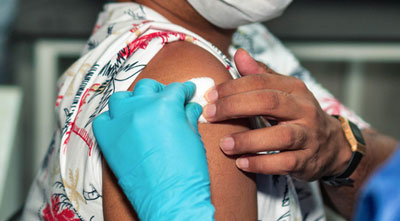
While employers anticipate a decision by the U.S. Supreme Court about the administration’s controversial vaccine mandate, the Cal/OSHA Standards Board has put a potential vote on the California version of the regulation on its January 20th agenda. California appears poised to adopt pertinent sections of the federal standard under the ‘Horcher’ rule.
The Horcher adoption would add two new sections to the Title 8 COVID emergency temporary standard, §§ 3205.5 and .6, covering vaccination, testing, face coverings, and “severability.”
It is unknown what the Standards Board might do should the Supreme Court rule to reinstate a stay of the federal mandate.
The high court could enjoin all or part of the regulation. In oral arguments last week, several Justices appeared skeptical of the broad mandate, which requires employers with at least 100 employees to mandate vaccination, with a testing alternative. But they seemed more inclined to uphold a similar requirement for healthcare.
The regulation was granted a temporary injunction by the U.S. Court of Appeal, Fifth Circuit. But the Sixth Circuit subsequently lifted the stay, putting the issue in the lap of the Supreme Court. “OSHA can now once again implement this vital workplace health standard,” Fed-OSHA said at the time.
“California is required to be at least as effective as Federal OSHA,” says Department of Industrial Relations public information officer Peter Melton. “The stay of the Federal COVID-19 regulations was lifted by the Sixth Circuit, requiring California to take action in order to become ‘at least as effective as’ that regulation.”
Melton adds that the Supreme Court, while hearing arguments for and against the rule, “has not [so far] prevented the Federal ETS from going into effect.” If the court rules against the mandate, Cal/OSHA will review the decision “as promptly as possible. California will not enforce any element or elements of the regulation that are enjoined.”
He also notes that the ETS includes the severability clause, which is a method to ensure that if part of a law or regulation is struck down, the remainder can stay in effect. “If the U.S. Supreme Court allows some portions of the Federal ETS to be enforced but not others, California would still be required to be ‘at least as effective as’ the portions which are allowed to go into effect,” Melton notes.
New Data Puts the ETS Standard in Question
New data confirms the vaccine does not prevent the spread of covid. In highly vaccinated countries, the contagions have been spreading. Countries like Spain and Israel, where more than 85% of the populations are vaccinated with two or more doses, are seeing record numbers of infections. The United States, too, is seeing record numbers, although varying by region.
However, measuring the number of infections without accurately tracking and reporting the number of serious cases or deaths does not tell the story. And American officials have failed in that kind of accuracy.
Federal and state government officials are now backing down from the previously reported death numbers. Center Disease Control’s Director, Dr. Rochelle Walensky said on ABC’s Good Morning America that 75% of the adult deaths reported as covid were in people with four or more comorbidities. That essentially drops the number of Covid specific deaths from the 800,000 reported to 200,000. Compared to the infection numbers, that count places the death rate below the Spanish Flu and possibly below the seasonal flu.
California officials last week admitted to a blind spot leading to the reporting of incorrect numbers. While extending California’s mask mandate, Dr. Mark Ghaly, California’s top public health official, also indicated that of the 51,000 people hospitalized in California, only around 8,000 tested positive for covid. Most importantly, Ghaly admitted that the government could not determine whether the covid positive patients were in the hospital because of covid or if covid was merely incidental to why they were hospitalized.
There is no spike in hospitalizations despite government and general media reporting. As of Tuesday, approximately two-thirds of COVID-positive patients at Los Angeles County hospitals managed by the Los Angeles County Public Health Department were admitted for something other than the virus. On Monday, Marin County had 19 COVID patients — but some 42% were incidental cases. Some people would have us believe Berkeley is experiencing a “phenomenal” surge in cases. But over the last month, only three residents have been hospitalized for COVID. A woman who enters the hospital to give birth and leaves the next day, who incidentally tests positive for covid with no other symptoms, is currently counted as a covid patient.
FAQ Update
Cal/OSHA also has amended its frequently asked questions on the California COVID ETS to incorporate new guidance on isolation and quarantine periods from the California Department of Public Health.
The CDPH recommendations were made subsequent to the December 2021 adoption of the latest version of the ETS and not part of the regulation. Cal/OSHA is relying on Governor Gavin Newsom’s December 2020 executive order (N-84-20) “which states that the recommended isolation and quarantine periods in the ETS will be overridden by any CDPH isolation or quarantine recommendation if the ETS periods are longer than those recommended by CDPH,” DIR says.
Under the new guidance, employees who test positive for COVID-19 must be excluded from the workplace for at least five days; they can return after day five if symptoms are not present or are resolving, and a diagnostic specimen collected on day five or later is negative. If the employee does not test and the symptoms remain, the isolation period is ten days. An employee may not return to work unless the fever resolves.
The five-day period also applies to employees who have been in close contact with a person with COVID. Exposed employees must test on day five, and they can return if symptoms are not present and a test no sooner than day five comes up negative.

